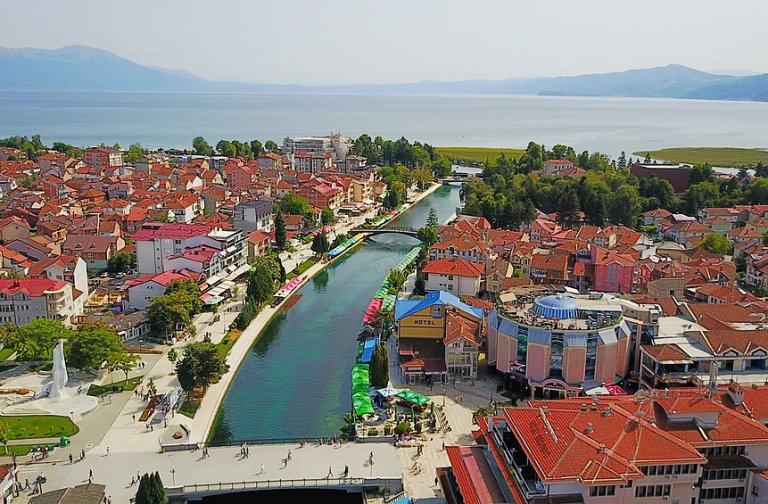STRUGA . . .
Struga (Macedonian: Струга ) is a town and popular tourist destination situated in the south-western region of North Macedonia, lying on the shore of Lake Ohrid. The town of Struga is the seat of Struga Municipality.
The name Struga was first mentioned in the 11th century. It is of Slavic origin and means a "river bed". Old boulevard of Struga.
The ancient name of the city is Enchalon (Εγχαλών), the ancient Greek word for eel, which may be related to the Illyrian Enchele tribe that was known to live in the region. According to E. Hamp, a connection with Albanian ngjalë makes it possible that the name Enchele was derived from the Illyrian term for eels, which may have been anciently related to Greek and simply adjusted to the Greek pronunciation. In Polybius the word 'Enchele' is written with a voiceless aspirate kh, Enchelanes, while in Mnaseas it was replaced with a voiced ng, Engelanes, the latter being a typical feature of the Ancient Macedonian and northern Paleo-Balkan languages.
 |
 |
History
In ancient times, the Lake Ohrid region, including Enchalon (ancient name of modern Struga) was inhabited by the Illyrian Enchele and Dassareti tribes. The Via Egnatia ran through the Lake Ohrid region, and is believed to have passed west of Enchalon.
Etymologist Qemal Murati believes that the name Strugë-a was first used as the name of a village; this name was used in a document of Tsar Dusan in the 14th century in the form of Struga. Later, in the 16th-17th centuries, the Codex of Slepçan, the name 'Strugi' was used.
During the 16th century, Struga was located in the Sanjak of Ohrid of the Ottoman Empire. It was registered as a Christian village in the Nahiya of Ohrid with 184 Christian families, 20 unmarried men and 36 widows, as well as 8 Muslim families.
In the late 19th and early 20th century, Struga was part of the Manastir Vilayet of the Ottoman Empire.
Struga was the birthplace in 1865 Ibrahim Temo, who would go on to be a doctor and one of the founders of the Ottoman reform movement known as the Committee of Union and Progress.
From 1929 to 1941, Struga was part of the Vardar Banovina of the Kingdom of Yugoslavia.
Places of interest and monuments
Great Mosque of Struga
Wooden weir at the outlet of Lake Ohrid
The hamam of Struga in the city centre, partly dilapidated and not accessible
Mother Teresa statue in the central square of the same name
Much of the town's income is through internal tourism. Struga's location on Lake Ohrid makes it a slightly quieter and more peaceful experience than the more bustling Ohrid.
When visiting this quiet town of North Macedonia, there are a few other places that show the beauty and culture, like the clay chamber pots at the house of the Miladinovci Brothers, the old bazaar, the century-old churches and mosques.
Before the evenings you can enjoy on 3 kinds of beaches called "Male beach" (maška plaža), "Female beach" (Ženska plaža) and Galeb ("Gull Beach"), located just before the estuary of the river Crn Drim (Black Drim) in its own flow, and between the two previous beaches.
Just in front of the "Male beach", at the estuary of the river Crn Drim it is located the biggest 5 star Hotel Drim in Struga.
Out of the town there is another tourist place near the lake called Biser (Pearl), also a hotel.
Every August the Struga Poetry Evenings (SPE) are held at the "Poetry Bridge" (Macedonian: Струшки Вечери на Поезијата) and are attended by poets, writers and artists from across the world.
 |
 |
Great Mosque of Struga Mother Teresa statue
 |
 |
Bazaar of Struga Typical Ottoman architecture